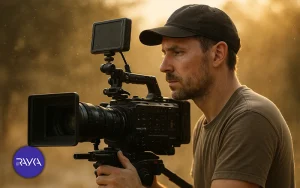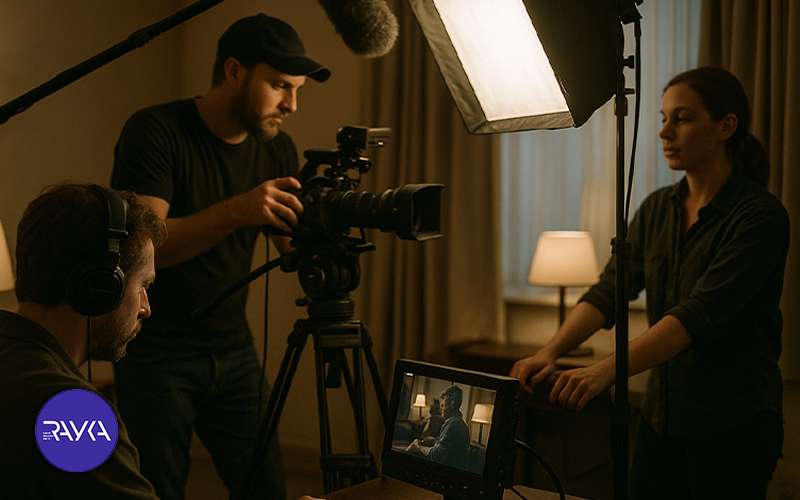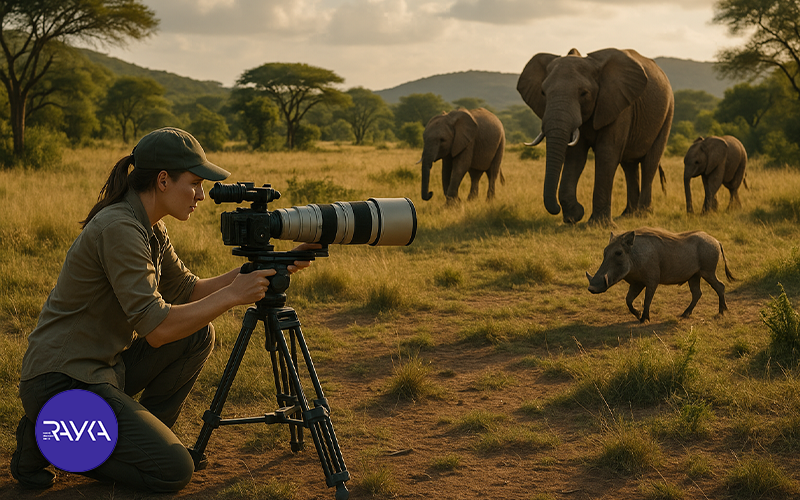
Documentary filmmaking is an art of transforming reality into a compelling, informative, or inspiring narrative. When we talk about the “principles of documentary production,” we refer to frameworks that ensure a documentary has a meaningful message and engages the audience. However, principles alone are not enough; practical tips and tricks are what elevate a documentary from ordinary to professional.
In this article, we focus on both the foundational concepts of documentary production and lesser-known technical and creative insights that can significantly enhance the final work.
To produce a professional documentary, one must start from the basics: understanding the purpose, subject, structure, and proper production process.
Before filming or editing begins, a precise understanding of documentary principles is essential. These principles serve as the main pillars of a visual work, guiding the director from the ideation stage to distribution. Below, we review the key principles of documentary filmmaking, including defining the purpose, selecting the subject, conducting research, designing the structure, and planning the execution.
Understanding the concept of a documentary and defining its main purpose is the first step toward producing a successful work.
A documentary is a reality-based narrative created to inform, educate, or provide social analysis. Unlike fictional works, this cinematic form relies on representing reality and connects with the audience through honest imagery, sound, and storytelling. The filmmaker must know the message of the work and what understanding the audience is expected to gain before starting the project. A clear purpose lays the foundation for the structure and tone of the narrative.
The right subject is the starting point of any impactful documentary and shapes the content’s identity.
Selecting a subject and idea for a documentary should be based on social significance, originality, and visual storytelling potential. A topic capable of engaging the audience intellectually and emotionally adds depth and longevity to the documentary. At the beginning, the filmmaker needs to define the central question or main concern, which will guide the narrative. Considering cultural, human, and research dimensions is crucial when choosing the subject.
Thorough research forms the foundation of a documentary and ensures the credibility of the narrative.
During the research stage, information should be gathered from written, visual, and field sources. Using reliable sources, conducting expert interviews, and reviewing archives help create a trustworthy and factual narrative. Collected data must be analyzed and organized to form a logical structure for the story. The deeper the research, the more realistic and impactful the final result will be.
The structure and script serve as the roadmap of the narrative, maintaining story continuity.
The documentary script is written to organize information and determine the logical sequence of scenes. This includes designing the narrative, arranging chapters, and identifying peaks and troughs of the story. A well-prepared script prevents scattered information and gives the film thematic unity. At this stage, a balance must be maintained between the reality of the documentary and cinematic language so that the narrative remains natural yet engaging.
Technical planning ensures the organized execution of the project and prevents resource wastage.
Before filming begins, all technical and operational details of the project must be defined. This plan includes scheduling production stages, budgeting, selecting equipment, determining locations, obtaining permits, and coordinating with team members. Precise planning ensures that the production process runs smoothly, efficiently, and in alignment with the documentary’s artistic goals. Resource management at this stage has a direct impact on the quality and success of the final work.

Precise and creative execution in filming and editing gives a documentary its professional spirit.
After establishing the fundamental principles and planning, it is time to apply technical and operational methods in documentary production. This stage is where cinematic techniques, visual storytelling skills, and creative decisions bring reality to life. Following technical tips not only enhances image and sound quality but also makes the documentary more impactful for the audience. Below, we discuss the most important technical tips for documentary production.
Natural and controlled lighting shapes the visual identity of a documentary and affects how reality is perceived.
Lighting is a key aspect of documentary filming. Unlike fictional works, lighting in documentaries should help represent reality and create a natural, honest atmosphere. Following these principles ensures that the final image looks both beautiful and authentic:
Proper composition guides the viewer’s eye and reinforces the documentary’s message.
The choice of camera angle should serve the narrative, not just visual aesthetics. A low angle can convey the subject’s power and authority, while a high angle is often used to show vulnerability or weakness. Balanced composition using the rule of thirds naturally directs the viewer’s attention within the frame. In observational documentaries, handheld camera use enhances the sense of realism.
High-quality sound is as important as visuals in conveying reality.
In documentaries, audio often carries crucial information. To capture clear sound, shotgun or lavalier microphones should be placed at an appropriate distance from the subject. Eliminating environmental noise, controlling audio levels, and using natural sound effects in the final edit increase audience focus. Audio design should aim to preserve the authenticity of the environment, especially in scenes where emotion or dialogue plays a central role.
Editing is the stage where footage and scenes are transformed into a cohesive and impactful narrative.
Editing plays a vital role in maintaining the documentary’s coherence and conveying its message. Following these guidelines ensures the documentary remains authentic while gaining cinematic appeal:
Archival footage can enrich the historical context and background of the subject.
In many documentaries, archival images or old footage are used to reconstruct events or provide context. Smart use of these resources adds depth to the narrative and situates the audience within the timeline. These images should come from reliable, licensed sources to preserve the authenticity of the work.

Using artificial intelligence in documentary filmmaking makes the production process faster, more precise, and more creative.
AI can effectively assist filmmakers at various stages of documentary production. This technology enables rapid data processing, creation of visual and audio content, and intelligent audience analysis. By following these principles, high-quality and professional documentaries can be produced using AI:
Artificial intelligence makes documentary production faster, more precise, and more creative, offering filmmakers innovative capabilities.
Using AI in documentary production not only speeds up the process but also enhances the quality and impact of the work. The main benefits include the following:
| Benefit | Description |
|---|---|
| Faster Production | Data processing, scene generation, and initial editing are much faster with AI than traditional methods. |
| Cost Reduction | Reduced need for complex equipment, large teams, and long production times lowers the overall cost of documentary production. |
| Improved Accuracy and Data Analysis | AI analyzes multiple sources, archives, and interviews to select the best data for the narrative. |
| Creative Capabilities and Visual Effects | AI algorithms enable the creation of visual effects, animation, and intelligent sound design, enhancing the documentary’s appeal. |
| Audience-Specific Content | AI analyzes audience behavior and preferences, allowing production of versions tailored to their interests and needs. |
| Optimized Editing and Narrative | AI offers suggestions for scene rhythm, music synchronization, and narrative cohesion, making the editing process more professional. |
| Access to Extensive Resources | Rapid processing of archives, images, and related footage provides filmmakers with a wider range of resources. |
Using artificial intelligence offers many possibilities, but some challenges require professional management.
Although AI makes documentary production faster and more creative, successful implementation is difficult without specialized knowledge and experience. To ensure quality, narrative cohesion, and content authenticity, it is essential to involve experts in AI and documentary production. These professionals can select the right tools, optimize the production process, and ensure the documentary remains both authentic and engaging.
Raykamah, with extensive experience in documentary filmmaking and the use of AI, executes projects professionally and creatively.
As a leading institute in documentary production and visual content creation, Raikamah combines professional expertise with AI technology to produce unique, high-quality documentaries. The institute optimizes research, filming, editing, and sound design using AI tools and relies on specialists at every stage to ensure the documentaries are both realistic and captivating.
With Raykamah, it is possible to produce documentaries that not only meet professional cinematic standards but also have the potential to go viral and reach a wide audience. Raykamah’s successful track record across various projects guarantees the quality and impact of each documentary.
The success of a professional documentary requires adhering to the principles of documentary production and carefully executing both technical and narrative stages. From defining the purpose and selecting the right subject to conducting research, writing the script, technical planning, lighting, composition, sound recording, editing, and using archival footage and interviews, each stage directly impacts the quality and effectiveness of the work.
By following these principles and applying practical techniques, a documentary not only becomes realistic and credible but also delivers a coherent, engaging, and impactful narrative. Ultimately, balancing authenticity, creativity, and professionalism is the key to producing a successful documentary.